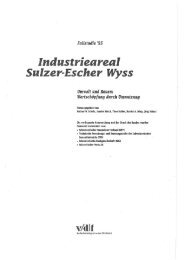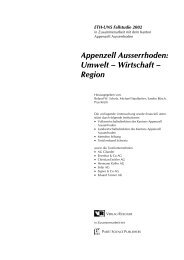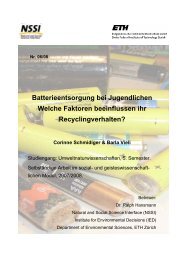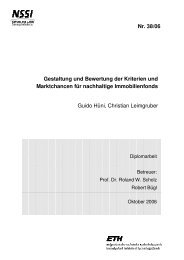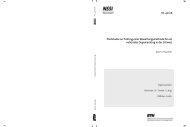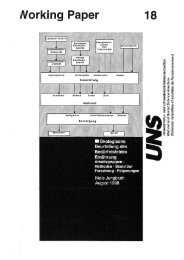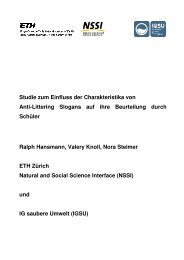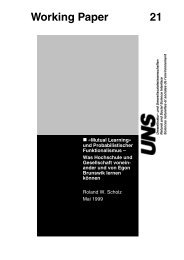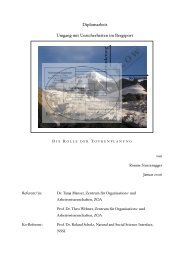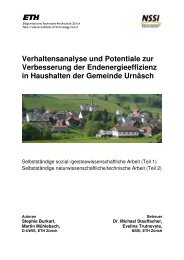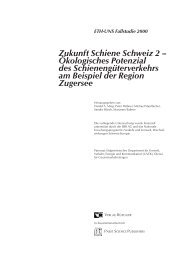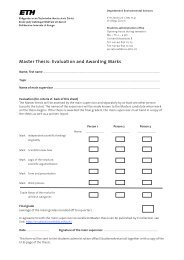Non-road fuel consumption and pollutant emissions ... - BAFU - CH
Non-road fuel consumption and pollutant emissions ... - BAFU - CH
Non-road fuel consumption and pollutant emissions ... - BAFU - CH
Create successful ePaper yourself
Turn your PDF publications into a flip-book with our unique Google optimized e-Paper software.
<strong>Non</strong>-<strong>road</strong> <strong>fuel</strong> <strong>consumption</strong> <strong>and</strong> <strong>pollutant</strong> <strong>emissions</strong> FOEN 2008 34<br />
4.3.5 Fuel <strong>consumption</strong><br />
<strong>Non</strong>-<strong>road</strong> <strong>fuel</strong> <strong>consumption</strong> is calculated using the same methodology as for <strong>pollutant</strong><br />
<strong>emissions</strong>. The <strong>fuel</strong> <strong>consumption</strong> factors of the various machine <strong>and</strong> engine types are<br />
listed in A4 on page 126.<br />
The <strong>consumption</strong> factors applied to diesel-powered machines are based on the data of<br />
the Environmental Protection Agency (USA) (EPA 2004). In line with the method used<br />
by the EPA, no chronological distinction of <strong>consumption</strong> factors in dependency on<br />
emission stages is made.<br />
The <strong>consumption</strong> factors for petrol-powered appliances are based on data in test reports<br />
carried out by the German Agricultural Society (Deutsche L<strong>and</strong>wirtschafts-Gesellschaft)<br />
(DLG 2008). The reduction of <strong>consumption</strong> in dependency on emission stages<br />
was chosen so that it runs parallel to hydrocarbon <strong>emissions</strong>.<br />
The <strong>consumption</strong> factors for ships/boats were adopted in accordance with the data contained<br />
in Report 49 (SAEFL 1996a). Due to the lower level of efficiency, the <strong>consumption</strong><br />
factors of steamships are significantly higher than those for motor vessels.<br />
The <strong>consumption</strong> factors for railway vehicles are based on the measurements of the<br />
IFEU (IFEU 2003) <strong>and</strong> on information provided by manufacturers of locomotives used<br />
by Swiss Federal Railways (SBB).<br />
Diesel-powered machinery<br />
(excluding marine <strong>and</strong> railway<br />
machinery)<br />
Small petrol-powered appliances<br />
Marine machinery<br />
Railway machinery<br />
4.3.6 Influencing factors<br />
Emission levels <strong>and</strong> the <strong>fuel</strong> <strong>consumption</strong> of machines can be influenced by a variety<br />
of factors, as a result of which the effective emission <strong>and</strong> <strong>consumption</strong> levels may<br />
deviate from the underlying values. Where such influences can be identified, they are<br />
adjusted with the aid of correction factors (CF).<br />
As a rule, machines are operated at partial load. This means that, for calculation of<br />
<strong>emissions</strong> the engine rated power has to be reduced by a load factor to the effective<br />
engine power. Load factors vary according to type <strong>and</strong> age of the machine<br />
13 . A6 on<br />
page 135 contains a list of the load factors for the various machine categories <strong>and</strong><br />
types.<br />
Load (CF1)<br />
In the case of diesel machines, the emission <strong>and</strong> <strong>consumption</strong> factors refer to use at<br />
48% of full load. This corresponds to the mean load of the ISO C1 non-<strong>road</strong> measurement<br />
cycle. In practice, however, certain machines are operated at a different mean<br />
load (for example, diesel railway vehicles in Switzerl<strong>and</strong> are primarily used for shunting<br />
operations at low engine load), <strong>and</strong> this means that the st<strong>and</strong>ard load factor for<br />
13<br />
A dependency of the load factor on the age of the machine only applies to agricultural tractors, since unlike other machine types, old<br />
tractors continue to be used for many more years, but are often only required to perform less dem<strong>and</strong>ing tasks with correspondingly low<br />
engine loads.



